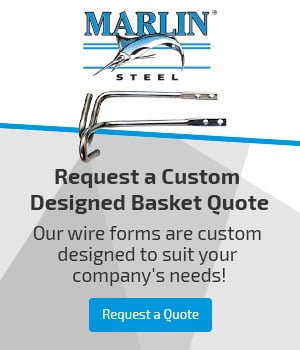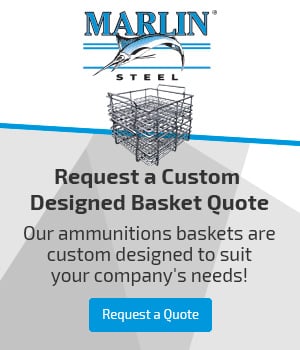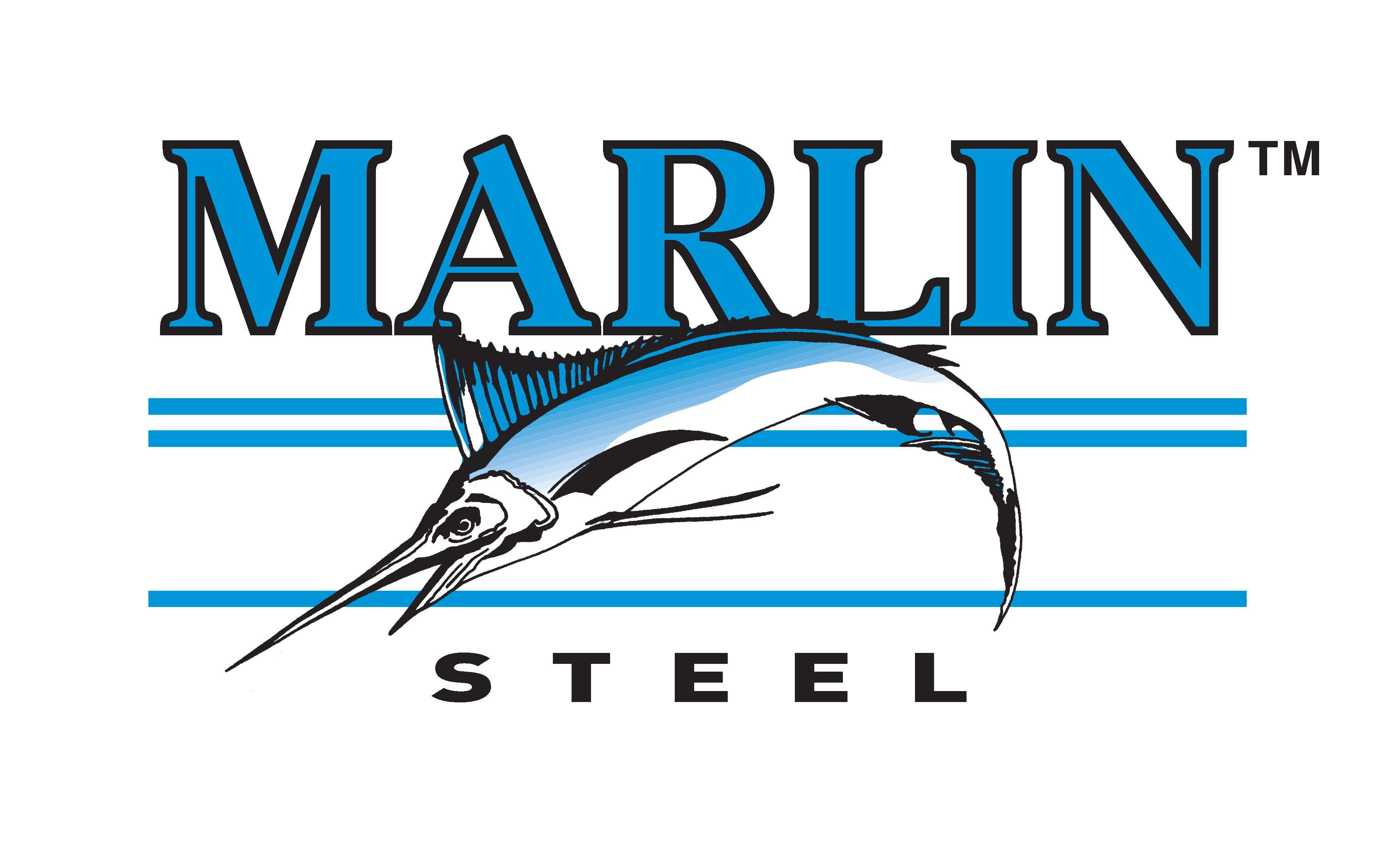Marlin Steel and the steel industry in general is unique in that it works with raw materials to provide products to a wide variety of industries which seem quite disparate. It’s what happens when the high quality American made product is remarkably versatile, durable, cost-effective, and able to meet the strict regulations set forth by many of these industries. Across each of the industries Marlin Steel works with, the handling of materials for sanitation or cleaning presents challenges and obstacles. Sometimes the obstacle has to do with material needs, such as:
- Air flow for proper drying
- Chemicals, temperatures, or other stresses needed to clean or sanitize
- Environmental versatility of the basket (to move from one manufacturing process to another)
- Custom design needs for the size, shape, or weight of the materials
Regardless of the industry, stainless steel wire baskets are an ideal choice for manufacturing or cleaning needs.
Quick Links
- 10 Reasons that Steel is Better for Materials Handling than Plastic
- 3 Benefits of Steel Fabrications for Material Handling Baskets
- 3 Tips for Choosing “Everlasting” Material Handling Solutions
- 4 examples of Material Handling Baskets
- 2 Case Studies: Material Handling Baskets
10 Reasons that Steel is Better for Materials Handling than Plastic
For quite some time plastic, due to its perceived durability and its mold-ability, was believed to be the best solution for material handling. While plastic certainly does have its perks, when it comes to materials handling, there’s really nothing that compares to American Steel. Here’s 10 reasons why steel is superior:
- More temperature resistance: Steel can withstand a wider range of temperatures compared to most commercial plastics. Even with recent advancements in plastics, steel outperforms. In fact, the operating range of steel is -150 F to +1600 F (-101 C to +871 C) while the operating range of plastics is -60 F to 250 F (-51 C to +121 C), although there are specialty plastics with a somewhat higher range. Further, steel can withstand rapid or cyclic temperature fluctuations better than most plastics.
- More corrosion resistance: Stainless steel resists corrosion in atmospheric and pure water environments. High-alloyed stainless steel grades resist corrosion in most acids, alkaline solutions, and chlorine environments. Most plastics, in contrast, cannot.
- More versatile: Steel can be coated with plastic to gain the benefits of both products. Further, while plastics can be molded, in terms of versatility, metal can be molded, shaped, cut, bent, welded, and assembled in a myriad of ways whereas plastics can be limited.
- Cleaner: Industrial oils, grease and solvents stain plastic more deeply than steel, making it harder to keep clean. Stainless steel surfaces are easier to maintain in original appearance. Further, with electropolishing, a stainless steel surface becomes easier to sanitize and sterilize for food and medical grade steels.
- Stronger: Steel has greater tensile strength and is more durable. Further, ventilation holes degrade the strength of a plastic washing container more than they do in wire mesh or laser-cut sheet metal.
- Less water absorption: Steel does not absorb water. Depending on the plastic, there is some water absorption, which may compromise the plastic itself or create other issues depending on the industry and presence of bacterial growth.
- Greater protection against fire: Special high chromium and nickel-alloyed steels resist scaling and retain strength even at high temperatures. In contrast, plastics may melt when exposed to flames and, in the process of melting, may release harmful chemicals.
- Less expensive to manufacture: Marlin Steel uses simple forming methods to make steel products. In contrast, most plastics require a custom mold, requiring a high up-front tooling cost, which often restricts plastic for only very high volume applications.
- Less expensive long-term: When total life cycle costs are considered, including initial tooling, stainless steel is often a less expensive material option. Further, its durability makes it a sound investment for long-term use.
- More sustainable: While plastics break down much faster, it’s still not environmentally sustainable. Further, most plastics come from petroleum, a non-renewable, often imported resource. On the other hand, steel is recyclable and reusable. It can be melted down and repurposed if necessary.
3 Benefits of Steel Fabrications for Material Handling Baskets
Stainless steel material handling baskets can have a huge impact on the efficiency of your company’s parts finishing processes. A well-designed basket is effective at keeping parts safe from damage, and is often useful for a variety of processes. Further, one that is custom designed specifically for your needs and materials may amplify these benefits.
Many manufacturers rely on plastic baskets for their parts handling needs for a variety of reasons, including low initial cost and softer surfaces that are less likely to scratch parts. However, using steel fabrications for material handling baskets can provide a number of benefits that significantly outweigh the benefits of using plastic.
Here’s a short list:
1: Higher Load Capacity
On average, steel has a much higher tensile strength than plastic. Just how much higher depends on what specific steel alloy you use and the exact plastic polymer you’re comparing it to.
The higher tensile strength means stainless steel wire baskets can easily handle loads that would crush a frame made of plastic.
For example, as cited on the Precision Steel website, type 301 annealed steel has a minimum tensile strength of 90,000 PSI (pounds per square inch), or about 620 MPa (Megapascals). Compare this to the tensile strength of a polymide + glass fiber polymer which, according to Matweb’s Material Property Data chart, is 150 MPa, or about 21,755 PSI.
Type 301 annealed steel is one of the weaker steel alloys, and it’s still four times as strong as one of the toughest polymers on the market.
2: Heat Resistance
There are a number of plastic polymers marketed as “heat resistant.” However, compared to steel, even a heat resistant plastic isn’t very resistant to heat at all.
For example, there’s a polymer called Vespel™ from Dupont™ that can take temperatures of 750 degrees Fahrenheit (400 degrees Celsius) without melting, and has an operational temperature of 500 degrees Fahrenheit (260 Celsius).
As high as this limit is, it’s nothing compared to the melting point of a basic stainless steel alloy, which is about 2,550 degrees Fahrenheit (1,363 degrees Celsius). This makes steel more than three times as tough to melt as a leading “heat resistant” polymer.
This allows material handling baskets made from steel to be used in applications that would melt a polymer basket equivalent, such as heat treating. The high temperature tolerance of steel allows baskets made from this material to pass through oven-like temperatures with ease without degrading or losing tensile strength like a plastic container would.
3: Longer Useful Life
There are a number of factors that can cause a plastic basket to fall apart, such as:
- Heavier loads straining/breaking the basket’s frame
- High temperatures damaging the polymer’s bonds
- Chemicals soaking into the basket and contaminating it
- Oxygenation of the basket decaying its molecular structure
These issues can weaken a plastic basket, wearing it out, and shortening its useful life. The sheer durability of steel allows steel material handling baskets to outlast plastic ones by a large margin. In many cases, the longer useful life of steel helps make steel materials handling baskets less costly to own than plastic ones over time.
Stainless steel wire baskets are also better able to resist many of the issues listed above, better than certain plastic polymers. For example, stainless steel is less absorbent than plastic, so accumulated chemicals are easier to remove.
Further, stainless steel alloys are resistant to oxidation corrosion, as they have a thin layer of oxides that prevent other oxides from attaching. Stainless steel simply makes for a tougher, longer-lasting, and more reliable materials handling basket than plastic alone.
3 Tips for Choosing “Everlasting” Material Handling Solutions
In many manufacturing applications, material handling baskets, trays, and carts used are put through enormous levels of stress including heavy loads, caustic environments, extreme temperatures, and job site accidents can all significantly reduce the useful life of your material handling solutions. These, in turn, can lead to more frequent replacement of the material handling baskets, trays, or carts, as well as a higher total cost of ownership.
While no material handling solution will be truly “everlasting” in all manufacturing applications, there are a few things that you can do to make sure that the one you choose will last as long as possible:
1: Consider the Environment the Material Handling Basket or Tray Will Be Used In
One of the most common mistakes leading to premature wear and tear that Marlin’s degreed engineers have run across is that the designers of a stainless steel wire basket or tray may not account for the environment the part would be used and stored in.
Some things that have doomed a parts handling solution to premature ruin include (but aren’t limited to):
- Ambient humidity
- Salt particles in the air
- Extreme temperatures
- Exposure to ultraviolet light
Different basket/tray materials and coatings react differently to environmental stresses. For example, niloxy high solid coats degrade severely when exposed to UV light—and should never be stored or used where natural sunlight is a factor. Some metals may become brittle at low temperatures, increasing their risk of shattering during winter months in areas with colder climates.
These are all factors that affect the basket or tray when it isn’t in use—and too many designers neglect to account for them. Instead, they worry only about the specific use conditions in the manufacturing plant, such as when the materials handling solution is going through a wash process or another task.
By taking into account other environmental factors, such as the plant’s location relative to the sea (for saltwater exposure), where the baskets/trays will be stored, ambient humidity and temperature, it is possible to improve the design for better long-term survivability.
2: Exceeding the Minimum Recommended Requirements for the Application
A basket or tray that barely meets the minimum recommended durability requirements is more prone to failure than one that surpasses them. There are a number of circumstances in which a material handling solution might be exposed to greater stresses than those specified in the processes it was originally designed for.
For example, a basket that might be dropped by its handler or a parts washing process can be tweaked to use slightly stronger chemicals. In such cases, a subpar basket frame might get damaged. On the other hand, a basket designed to take greater stresses will be more likely to survive such situations.
For this reason, a little bit of over-designing against future process upgrades or accidents keeps a stainless steel materials handling basket in working condition longer. Picking basket or tray materials that exceed your minimum requirements can help to create an “everlasting” materials handling solution.
3: Consider Ongoing Care for the Basket/Tray
Every custom stainless steel wire basket or tray is going to need some basic maintenance, no matter how durable it is. One of the keys to picking a top-class materials handling solution is to ask the manufacturer how it should be maintained.
This helps you identify major maintenance risks that may exist for the basket or tray. For example, stainless steel trays should never be cleaned with a plain steel or iron brush because the iron molecules in the brush can be transferred to the stainless alloy’s surface compromising the protective oxide layer that prevents rust.
One of the most critical tips, however, is to consult an experienced mechanical engineer first. A mechanical engineer with extensive experience is better equipped to anticipate the many different environmental factors that can destroy a materials handling basket.
Additionally, these degreed engineers should have access to some kind of virtual physics simulation software, such as a Finite Element Analysis (FEA) software, that can recreate the effects of different real-world conditions on a design. This kind of software ensures that any materials handling basket or tray design is as robust and durable as possible by identifying potential faults, informing the engineer to fix them.
4 Examples of Material Handling Baskets
There is no “one size fits all” solution that meets every need. While one company might need a material handling basket that can safely hold many small parts through a caustic washing process, another might need a basket that can hold materials weighing several hundred pounds. This is why Marlin Steel’s degreed engineers frequently create new custom wire baskets for the company’s clients.
Here are a few examples of some of the custom steel wire baskets that Marlin degreed engineers have designed for other clients in the past—along with an explanation of their design features and why they were included: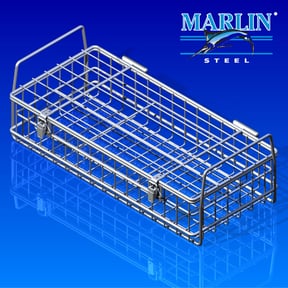 Material Handling Basket 837016
Material Handling Basket 837016
This custom wire basket was made from grade 304 stainless steel to withstand use in a caustic parts washing process where the basket and the parts it held would be submerged fully. Because the basket was to be used constantly in a full immersion process, it needed to have enough corrosion resistance to take continuous exposure to the client’s chemical wash process.
To help protect the parts, the basket included a latching lid to close and hold secure. The sides of the basket had enough open space to allow runoff from the wash process to drain with ease, but not so open that any of the parts could slide out of the basket.
A set of handles were added to this design to make it easier for workers to carry around the factory floor, helping to speed the basket’s contents along their manufacturing process.
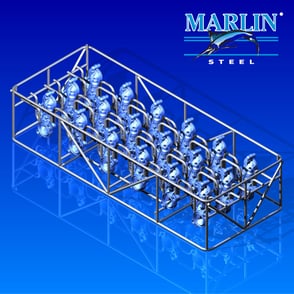 Material Handling Basket 2016004
Material Handling Basket 2016004
This stainless steel basket design needed to be open to allow optimal air flow and make accessing the parts inside as easy as possible. However, each part also needed to be held in place for an automated system to be able to insert or remove each one for processing. Also, the basket was nearly three feet long and more than a foot wide, and needed to be stackable to save floor space.
Marlin’s degreed engineers created an open-topped basket design with a custom wire insert that would hold each part at a precise angle and position. This allowed the client’s automated equipment to add or remove parts with ease while minimizing the risk of damage. Meanwhile, the edges of the basket were made with rounded edges so as not to catch on the conveyor belt that would move the basket from place to place in the automated manufacturing process.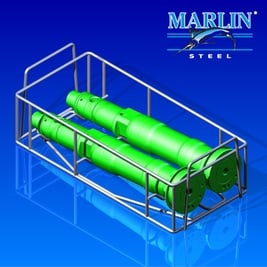 Material Handling Basket 938015
Material Handling Basket 938015
This basket design had a similar challenge as the one above as it needed to be open while holding parts in position. However, the size and shape of the parts to be held were completely different. Instead of holding over a dozen parts, this basket needed to hold two large cylindrical parts while still being easy to carry by hand.
Since the cylinders were wider at one end than the other, the custom insert for this basket had different-sized grooves at each end to ensure there would be no loading a part “backwards” in the basket. Also, one side of the wires were slightly elevated to allow any runoff from cleaning processes to drain away from the held parts. If both ends of the part were level, used cleaning fluid could pool inside the cylinder.
Handles were added that not only made the basket easy to carry, but would act as a guide when stacking the baskets as well. By making the baskets stackable, space could be saved on the client’s factory floor.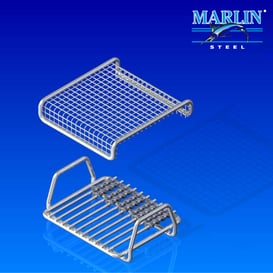 Material Handling Basket 710001
Material Handling Basket 710001
One of the biggest challenges in washing very small parts is that, during a rinse and wash process, the parts can easily be ejected from the basket. Normally, to fix this issue, a custom steel wire basket will use a complete enclosure that keeps parts from falling out.
However, in this custom wire basket application, the client wanted to keep parts held in a specific layout and wanted the parts to be easy to access for insertion or removal. Since a latched lid would be difficult to work with thick leather gloves, the client wanted a different solution.
Marlin’s degreed engineers proposed a somewhat unique, two-piece basket design that would provide the best combination of easy access and parts protection. The bottom piece was a basket with a set of thick wires the parts would rest on. Meanwhile, an upper piece would act as a wire mesh lid that would lay over the parts and hold them in place during the wash/rinse process.
Being held only by its own weight, the lid would be easy to remove, yet secure enough to keep parts from flying out of the basket during high-pressure wash processes. Two large handles would allow workers wearing extra-thick protective gloves to easily carry the basket between processes as well.
2 Case Studies: Material Handling Baskets
Marlin Steel prides itself on its quality products and on its creative and reliable custom solutions for its customers. Here’s a look at two situations that called for custom solutions in materials handling.
CASE STUDY: Creating Heavy-Duty Materials Handling Baskets for Wood Drying
Marlin’s degreed engineers were tasked with creating a heavy-duty wire materials handling basket for carrying up to 70 pounds of wood materials at a time to be kiln-dried at temperatures in excess of 250 degrees Fahrenheit for 4 hours at a time.
Challenges in the Design
The client had a few specific needs for this particular design:
- Safely hold up to 70 pounds of wood while providing sufficient air flow for drying
- Retain enough tensile strength to prevent wires from being deformed after hours of continuous exposure to an oven-like environment
- Easy to safely move by hand from one process to the next
Overcoming the Challenges
The old baskets the client used for their kiln-drying operations had served their purposes, but years of high-temperature oxidation and exposure to outdoor environments caused the plain steel to rust heavily, compromising its structural integrity.
To counteract the effects of prolonged exposure to high kiln operating temperatures and outdoor conditions without using stainless steel or specialized coatings was a tall order.
To prolong the useful life of the baskets, the thickness of the wires was increased. By increasing wire thickness, the loss of tensile strength from oxidation could be reduced as it would take longer for the basket to rust through. Also, using fewer thick wires helped to maximize open space in the design, aiding in the drying of lumber loaded into the basket.
To facilitate easier handling of the basket and its contents throughout the drying process, extra-large, thick wires were added as handles. These wires would also run under the basket frame as well, helping to support the weight of a full load so the thinner wires of the basket wouldn’t be bent out of shape.
Testing the Design
Before tooling for the basket ever began, the design of the basket was tested using Autodesk physics simulation software to show how the basket would react to prolonged use. If a basket design fails the test, Marlin’s degreed engineers get a detailed report of the failure and the cause so they can rework the design.
This simulated testing is repeated until a basket’s design finally passes muster. This not only prevents the manufacture of patently bad baskets, it’s much faster than physical testing. Virtual trials can be completed in minutes, while physical testing takes weeks or months.
Thanks to virtual testing, Marlin’s client got a shipment of new baskets quickly and was able to put them to use right away, preventing production delays.
CASE STUDY: Custom Material Handling Baskets: Creating the Perfect Plunger Basket
In a recent job for an automotive parts washing process, the customer had a very specific set of requirements for washing their parts. The part in question was for the rebuilding of injectors, and the washing process involved placing the basket in a tank with various chemicals at 150 °F for ten minutes at a time.
Not only that, but the cleaning process also involved the use of ultrasonics, so the basket needed to be designed to withstand the stresses of such high-frequency vibrations.
Movement of the basket between phases of the process was to be done by hand, with operators wearing protective gloves for safety.
With this information, Marlin Steel’s degreed engineers were able to pick the right materials for the basket, but the hard part was designing a basket that could hold 322 cylindrical parts in place without allowing them to move around, and still be able to release all parts quickly at the end of the wash process. Not only that, but in order to ensure the best cleaning performance, there had to be as little material between the part and the cleaning medium as possible, so the final design needed to be as “open-air” as possible.
Holding Narrow Cylinders in Place without a Mesh Cage
The final solution was relatively simple, but elegant. Instead of making a wire mesh basket with a lid, or a straight sheet metal box, Marlin Steel’s degreed engineers used a wire frame with several custom-cut sheet metal plates to hold the parts in place.
Since each part had a slightly narrow “neck” just below the head of the unit, the basket was designed as a plunger basket. Two layers of sheet metal were precision cut to hold the hundreds of narrow cylinders in place securely. One layer was cut to form hundreds of “L” shapes, and the other layer had hundreds of corresponding keyhole-like shapes with a wide and a narrow end cut into them.
The part would fit into the larger circle portion of the keyhole shape, then slide up into the narrower part of the shape. Once all 322 parts are in place, the lock sheet slides over, covering the large holes with the other piece of sheet metal and securing all of the cylinders in place.
This gave the parts maximum exposure to the cleaning process and coatings they needed to be ready for final assembly, while keeping them in place so that they would not get lost inside the parts washing machine.
Making it Easy to Load and Unload
The basket also had to be designed in such a way as to allow an operator easy access to load and unload the parts. To this end, the frame of the basket is designed to be open and hold the parts far enough from the base to comfortably fit a forearm underneath. This allows operators to load the parts from the underside of the basket as well as from the top.
To facilitate the quick release of parts, a quick-release pin was added. This pin holds the lock sheet in the closed position during the wash, and can be used to keep the sheet in the open position during the unloading process.
Using the Perfect Materials for the Job
When Marlin Steel’s degreed engineers were first given the task of making this basket, the customer’s initial request was for plain steel. However, after a review of the washing process, it was determined that plain steel would not last long enough to be cost-effective, as it would require frequent replacement.
Grade 304 stainless steel, on the other hand, was found to be much more compatible with the client’s wash process while still being cost effective. Marlin’s degreed engineers brought this to the customer’s attention, and talked them through how using 304 SS would save money in the long run.
The change was made, and this customer was spared the expense of having to re-order new baskets a month or two down the road. Instead of simply giving the customer an inferior product that would not have met their needs, Marlin Steel’s degreed engineers identified a potential problem and offered a solution.
By consulting with clients and making them aware of issues that can affect the performance and longevity of their products, Marlin Steel’s degreed engineers strive to ensure that their clients get the perfect parts washing baskets to meet their needs.
Regardless of your industry, Marlin Steel is here to help you meet your challenges and provide you with customized solutions that exceed your expectations. Get in touch with our team today to let us help you with your customized stainless steel wire basket needs.




.gif)
